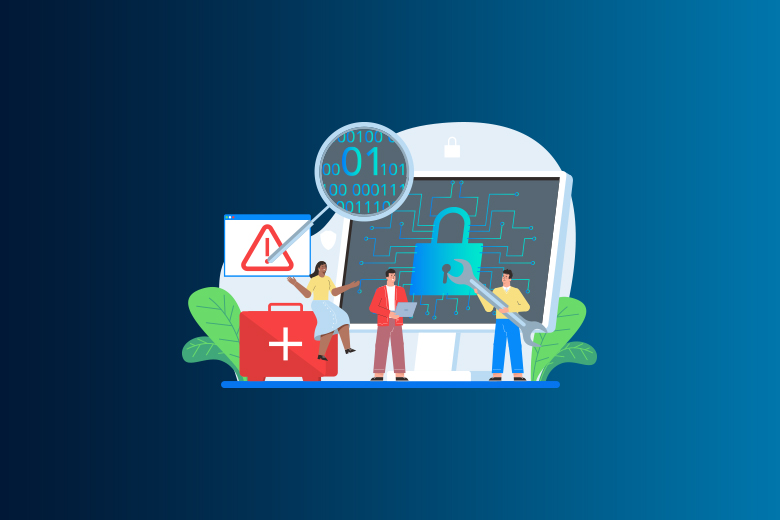18 March 2024
SafeAeon Inc.Cybersecurity threats are always changing. Even though firewalls and antivirus software are very important for protection, attackers are increasingly using psychological tricks to get into systems and information that they shouldn't have access to. This method called reverse social engineering (RSE), is the opposite of normal strikes because it gets people to ask the attacker for help.
A scary picture is painted by new studies from the FBI's Internet Crime Complaint Center (ICCC). BEC (Business Email Compromise) scams, which are a common type of RSE, cost people a huge $8 billion in 2022 alone. These numbers show that RSE tactics are getting smarter and more successful.
RSE is different from standard social engineering because instead of attackers starting the conversation, users are tricked into asking for help. Several ways can be used to make this happen. A common trick is to use fake pop-up warnings that look like serious system failures or virus alerts with big "technical support" numbers. To make things even scarier, some attackers use remote access tools to break the victim's device, making them feel like they need to get "help" right away.
Once the user gets in touch with the attacker, they often pretend to be IT help or security staff to make themselves seem trustworthy. By taking advantage of the user's fear and confusion, the attacker can get them to give up private information, allow remote access to systems, or even send money under the guise of fixing the fake problem.
Both people and businesses need to understand RSE tactics. By knowing the tricks that attackers use to trick people, users can stay alert and avoid falling for these misleading schemes.
What does "reverse social engineering" mean?
Reverse social engineering, or RSE is a more complex type of social engineering attack that involves talking to people directly to get personal information. RSE is different from other ways because the attacker starts the conversation, usually through emails or social media, pretending to be a helpful person or security expert. Even though this strategy seems old-fashioned, it still works very well, especially when the target thinks their system has been hacked.
Social vs. Reverse Social Engineering: Understanding the Difference
The most important difference is how touch is made. In most cases of social engineering, the attackers get in touch with their victims. In reverse social engineering, on the other hand, victims are tricked into talking to the attackers, which makes the attackers look more trustworthy without the victims knowing it.
How does social engineering in reverse work?
As shown in a step-by-step guide, the process goes like this:
- First Contact Through Scam: The target clicks on a scam link and gets harmful software on their computer without meaning to.
- Authority Figure Impersonation: The attacker calls the target and pretends to be a security expert or other important person. They offer to fix the system's problems for a small fee or for free.
- Building Trust and Access: The attacker gets into the victim's system by making themselves look like a trustworthy option.
- Backdoor Creation: While fixing the supposed problems, the attacker secretly builds a backdoor that lets them watch what the victim does online and steal data.
- Victim-Initiated Contact: Sometimes, the attacker waits for the victim to make contact to make their name and services seem more trustworthy.
- Making the Victim Need Help: Hackers may damage the victim's system by removing files or changing system settings, which forces the victim to need help.
- Strategic Advertising: The attacker makes sure that the victim sees their offer of help, which is usually done through strategically put ads or interactions on social media.
- Building Trust on Social Media: Attackers can also get to know their target better on social media sites, which makes them even more trustworthy.
This careful approach not only protects the attacker's way into the victim's system but also strengthens their position of trust, which makes the victim much less likely to suspect anything and makes the attack much more effective.
Factors Contributing to Reverse Social Engineering
Two main things determine how well reverse social engineering techniques work:
- Insufficient Security Awareness
- Inadequate Security Measures and Planning
Small to medium-sized businesses may be affected by both factors, especially if they don't have a strong information security system or don't put enough emphasis on security. Individual users are most likely to be affected by the first factor.
Insufficient Security Awareness
People are often seen as the weakest link in security, and a lot of malware gets into systems through phishing and other social engineering tactics. Even though there are security rules that say you shouldn't share private information like usernames, passwords, and financial transaction information, users still don't understand and follow these rules. People often forget to do simple things to keep their information safe, like using multi-factor login and staying away from emails and links that seem sketchy. It came as a surprise to many that about 26% of people who use the internet have given their OTPs to other people.
People share knowledge for a variety of reasons, such as to make things easier or because they want to help others. People may feel obligated to share private information if they think the person asking for it is in a position of power, like a boss, a government worker, or the police. When users realize that their systems or data have been hacked, they may become panicked, which can make them easy targets for reverse social engineering. Hackers take advantage of these weaknesses in people's minds.
Inadequate Security Measures and Planning
Many businesses are aware that security breaches are a risk, but they don't want to spend money on more advanced security solutions because they think their current tools are enough. Even though people are trying to combine security technologies and standards, it's still not clear how well they work without thorough testing. Cybersecurity experts say that relying on internal checks to evaluate these systems is a very bad idea.
Companies that deal with private information are more likely to be hacked, so they need stricter security rules that include strong authentication and protection. It is very important to test security measures regularly, which requires a thorough strategy. There is still a gap between policy and practice when it comes to security in many companies. It is often shown to be unrealistic to think that workers are aware of security risks. Realistic plans are needed right away to teach workers about security best practices and stress how important it is to keep learning and taking steps to protect against threats.
How to Stop Reverse Social Engineering Attacks?
People who don't know enough about security and don't follow security best practices often fall for reverse social engineering attacks because they make hasty choices out of panic. If you make these kinds of choices, you might end up getting help from tech support that you can't be sure of, which could help the attacker. So, the ways to stop backward social engineering are the same as the ways to stop regular social engineering:
- Getting Cybersavvy: It's important to teach team members and people about cybersecurity and make them aware of it. Because of this information, real incident reaction teams and tech support staff can be easily identified.
- Believing in Reliable Cybersecurity Companies: People and businesses should trust well-known cybersecurity services and companies to lower their chances of falling for scams.
- Encouraging Quick Reporting: Employees should be told to tell their company's security boss or a related security provider right away about any strange or suspicious behavior.
- Hiring Alert Analysts: Companies should hire alert analysts who can quickly spot possible threats and let the security team and the rest of the company know about them.
- Validating Software and Updates: Before integrating new software or updates, the security team should carefully check to make sure they are safe and won't harm the organization's digital identity.
- Setting Guidelines for Peripheral Devices: It's important to teach workers about the risks of using disks, USBs, and other peripherals without doing the right security checks.
- Putting in place full-scale security measures: Using full-scale security solutions from top-tier providers can fix specific business weaknesses and stop workers from downloading software or apps from the internet that haven't been checked out.
By using these methods, people and businesses can make themselves much more resistant to reverse social engineering attacks, keeping their data and operations safe from such smart threats.
Conclusion
In the world of online threats, reverse social engineering stands out. It uses complex strategies that play on people's minds. The goal of this trick is to get private data. People and organizations can get ready for these tactics by understanding how they work. The best protection is knowledge and awareness. They stress how important it is to be skeptical and check things out, especially when someone asks for help or information without being asked. It is important to build a mindset of security. Reverse social engineering risks can be reduced with strong security policies and regular training. To deal with the complicated world of cybersecurity, you need to stay aware and alert. SafeAeon can be your best bet for this.














